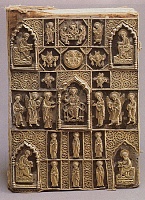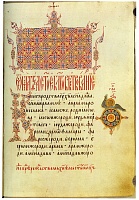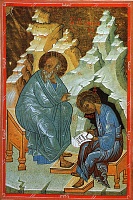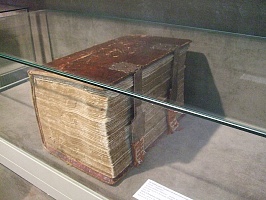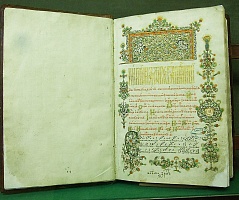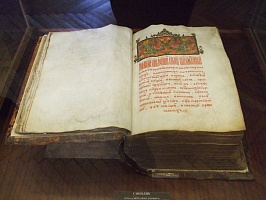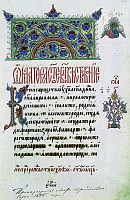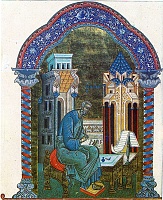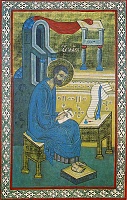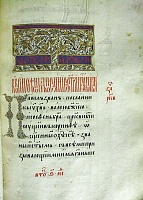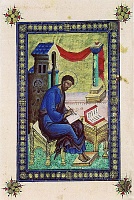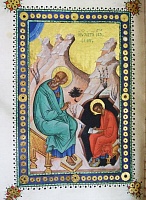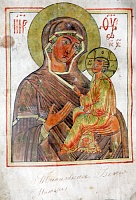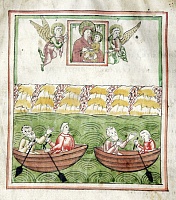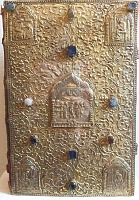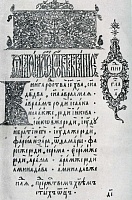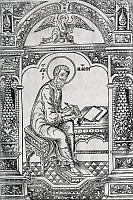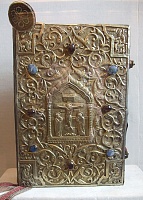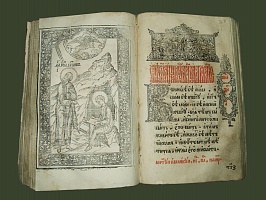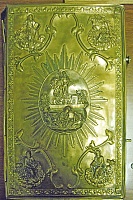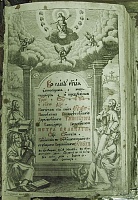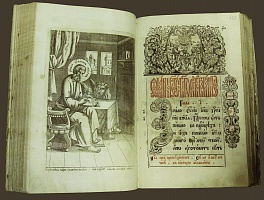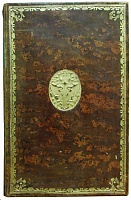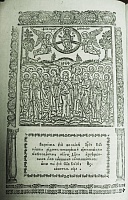Manuscripts and Old Printed Books of the 14th – 19th Centuries
Actually, the formation of the manuscript collection began simultaneously with the Museum establishment in April 20, 1920. The important role was played by the Commission on the protection of history and art monuments of the Trinity-St. Sergius Lavra, organized in October, 1918 to transfer the Monastery treasures to the state. The book collection of the Trinity-St. Sergius Lavra was also within its responsibility. However, the majority of manuscripts from the unique Monastery collection passed to the State Lenin Library in Moscow in the 1930s. The act was finely confirmed by decision (№ 50) of the USSR Ministry of Culture, issued in February 3, 1955.
The unique part of the Museum manuscript collection is represented by two illuminated specimens - the Gospel and the Apostle of Moscow Metropolitan Iosaph (Skripitsin). The earliest Gospel from the Nikolo-Pesnoshsky Monastery arrived from the Dmitrov Museum in 1959. It is decorated with four colored miniatures with the images of the evangelists that are close to those in the icons of Dionysius - the famous artist of Old Russia. The Gospel was presumably written by Sergius Dobropisets, who was probably connected with the Trinity Monastery.
The book acquisition and investigation, which began during the Commission activity, resumed in the late 1950s. The new stage of collecting was the result of the Museum expeditions, aiming to discover monuments of Old Russian art. They were organized in the Moscow region and , mainly in the Sergiev Posad, former Zagorsk district, with its ancient settlements that used to belong to the Monastery or to the great landowners.
The memorial books included the Obituary of 1679, commissioned by boyar B.M. Khitrovo. Its preface contains the article about the visit of Ivan the Terrible to the Trinity Monastery in 1583 on the occasion of “ murder” of his son tsarevich Ivan. The Obituary was based on the earlier document of Ivan the Terrible’s time, dating back to 1575. The most valuable part for investigators records the memorial inscriptions of the late 17th –mid 19th century. The Obituary of 1679 was for the first time introduced for scientific research.
The manuscript titled The Book of Sticherion of the first quarter of the 17th century was composed by the famous Old Russian chanter Login Shishelov, nicknamed Cow. It originated from the former Trinity Monastery collection. The manuscript was illuminated with colorful and leaf gilded miniatures.
Three illuminated manuscripts of the 16th century from the collection of the Sergiev Posad Museum-Reserve are remarkable for their artistic quality. They are the Gospel of Deacon Iona Zuy and the Gospel of Archimandrite of the Trinity-St. Sergius Monastery Mercury Dmitrovets and the Apostle of Moscow Metropolitan Ioasaph. They were originally included into the group of the ancient manuscripts of the so-called sacristy collection.
It should be noted that in the 16th century, the local "school" of icon- painting was formed in the Trinity-St. Sergius Monastery, so it is not improbable that there were manuscript illuminators among the local artists. The Trinity origin of the manuscripts is confirmed by the social status of their owners whose historical destinies happened to be closely connected with the Trinity-St. Sergius Monastery.
Тhe third book – “ The Apostle” - is practically unknown to experts. “The Apostle” from the collection of the Sergiev Posad Museum is magnificently decorated according to the traditions of the first half of the 16th century. The book entirely corresponds to the high social position of its former owner - Metropolitan Ioasaph (Skripitsin) of Moscow. “The Apostle” is half- sheet in size. It is written in a beautiful half-running hand on 574 sheets with wide margins.
The manuscript is decorated on the same principle, as the Gospel mentioned above. Alternating miniatures and colorful head ornaments are used, but the illumination of “The Apostle” is more magnificent. The miniatures in all three books demonstrate one of the trends in the development of book illumination in the 16th century
“The Tale of the Icon Depicting the Virgin Hodigitria of Tikhvin”, dating back to the 1780s, is a noteworthy book in the Museum collection. This manuscript has not been noticed by the researchers yet. It belongs to the monuments of the late tradition. It is rather large (302 sheets) and richly illustrated (119 miniatures and 2 headpieces). The manuscript includes all narrations about the Virgin of Tikhvin, known in the 17th – 18th centuries.
The Museum possesses quite a number of albums, including Old Believers’ collections. One of the books is a chant manuscript – a copy of the 17th century document, written in the 19th century. It is richly decorated with feast compositions and ornaments in leaf-gold.
The books, printed in Cyrillic, constitute a considerable part of the collection comprises a large group of books printed in Cyrillic. The Museum collecting activity considerably enlarged the number of manuscripts and old printed books. At present, it totals over a thousand specimens. The basic part of the Museum collection comprise 59 books originated from the former repository of the Trinity-St.Sergius Lavra.
Two thirds of 524 books in Cyrillic were printed in Moscow in the 16th - 18th centuries. The editions of other printing houses, especially those of Warsaw, Wilno, Grodno, Kiev, Klintsy, Lvov, Ostrog, Pochayev, Suprasl and St.-Petersburg are represented by singular volumes. Among the early 17th century books we should point out the Gospel of A. M. Radishchevsky (1606), and the Gospel of Archimandrite Nektary of 1633. The Menology of 1690 in a cover of leather on boards, decorated with stamping, is an example of a church service book.
The most numerous group in the Museum collection consists of the 18th century editions, represented mainly by "ordinary", completely preserved volumes. The liturgical menologies (176 editions in 193 copies) and the Gospels (44 editions in 103 copies) are most numerous, i.e. they comprise more than a half of the whole collection. One of the reasons of their prevalence is their surviving precious binding or cover, decorated with engraving, niello, stamping, casting and, in some cases, with jewels.
The Gospel of 1722 can be referred to the 18th
century printed editions. One copy is in a velvet binding with enamel decorations, the other – in a binding of boards enclosed in a chased brass cover. The top board shows the Resurrection of Christ and Evangelists. The book «Acaphistus and Canons», published in Kiev in 1731, is perfectly illuminated. The pages of the book are framed with magnificent floral patterns.
The sample of a book in Cyrillic is «The Lives of St. Sergius of Radonezh and St. Savva Storozhevsky», edited by merchants Dm. Rukavishnikov and Jacob Zheleznikov’s Printery in Klintsy in 1786. The book cover is of embossed leather on boards. This book arrived from the small, but valuable collection of G.I. Mankovsky (Moscow). Nine books of this collection were selected for the Museum. They are monuments of Moscow, Ukrainian and Belorussian Cyrillic script of the 17th – 18th centuries
“The Homilies” of Abba Isaac Sirin is a rare 19th century edition. It was published by the Moldova Vlakhiysky Monastery in 1812. The book cover is of embossed leather..









